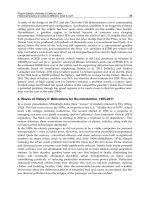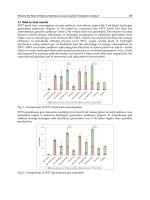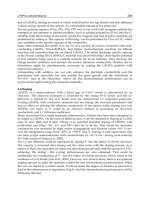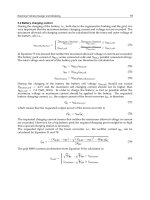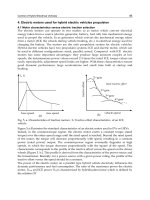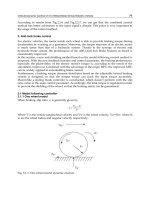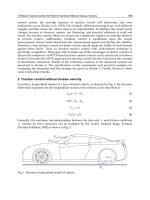Electric Vehicles Modelling and Simulations Part 12 pdf
Bạn đang xem bản rút gọn của tài liệu. Xem và tải ngay bản đầy đủ của tài liệu tại đây (1.03 MB, 30 trang )
DC/DC Converters for Electric Vehicles
319
Where:
V
out
: the output voltage,
∆IL
max
: the inductor current ripple,
F : the switching frequency.
IL
max
: the maximum input current,
∆V
out_max
: the maximum output voltage ripple.
Table 1 shows the specifications of the converter. The inductor current ripple value is
desired to be less than 5% of the maximum input current in the case of interfacing a Fuel
Cell. A ripple factor less than 4% for the Fuel Cell’s output current will have negligible
impact on the conditions within the Fuel Cell diffusion layer and thus will not severely
impact the Fuel Cell lifetime (Yu et al., 2007).
∆V
out_max
Output voltage ripple (1% of V
out
= 4 V)
V
out
Output voltage (400 V)
F Switching frequency (20 KHz)
IL
max
Inductor current (250 A)
∆ILmax Inductor current ripple (5% of ILmax = 12.5 A)
Table 1. Standard boost DC-DC converter parameters
6.2.1 Modeling and control
The output voltage is adjustable via the duty cycle α of the PWM signal switching the IGBT
as given in the following expression:
1
1
out
in
V
V a
=
-
(29)
The input voltage Vin is considered as constant (200V). The inductor and capacitor
resistances are not taken into account in the analysis of the converter. The converter can be
modeled by the following system of equations:
()
()
1
1
L
in out
out
Lout
di
vL uv
dt
dv
iuC i
dt
ì
ï
ï
=+-
ï
ï
ï
í
ï
ï
-= +
ï
ï
ï
î
(30)
This model can be used directly to simulate the converter. By replacing the variable u by its
average value which is the duty cycle during a sampling period makes it possible to obtain
the average model of the converter as illustrated in the following system of differential
equations:
()
()
1
1
L
in out
out
out
di
vL v
dt
dv
il C i
dt
a
a
ì
ï
ï
=+-
ï
ï
ï
í
ï
ï
-= +
ï
ï
ï
î
(31)
Electric Vehicles – Modelling and Simulations
320
Current control loop
The current control loop guarantees limited variations of the current trough the inductor
during important load variations. The inductor current and voltage models are given by
Equation 32 and Equation 33, respectively.
() () ()
()
()
(
)
1
1
in out
IL s V s s V s
Ls
a= ⋅
(32)
(
)
(
)
(
)
(
)
(
)
1
in out
VL s V s s V sa= ⋅ (33)
To make it simple to define a controller, the behavior of the system should be linearized. The
linearization is done by using an inverse model. Thus an expression between the output of
corrector and the voltage of the inductor should be found (Lachaize, 2004). Thus, the
following expression is proposed:
()
(
)
(
)
(
)
1
in
out
VL s V s
s
Vs
a
¢
-
=+
(34)
Where, VL’ is a new control variable represents the voltage reference of the inductor.
Thus, a linear transfer between VL’(s) and IL(s) is obtained by:
()
(
)
(
)
1
1
IL s
Ts
VL s Ls
==
¢
(35)
The structure of the regulator is a RST form. The polynomials R, S and T are calculated
using the methodology explained above. The bandwidth of the current loop ω
i
should be ten
times lower than the switching frequency.
2
,
10 10
ii
ff
f
p
w££
(36)
The inductor current loop is shown in Fig. 6.
ILref
+
-
Linearization
Boost
Converter
PWM
generator
'
L
V
L
I
RST
current
controller
1
zR
1
zT
11
zS
Fig. 6. Boost converter inductor current loop
From the reference value of the current and its measured value, The RST current controller
block will calculate the duty cycle as explained above.
Voltage control loop
The output voltage loop was designed following a similar strategy to the current loop. To
define the voltage controller, it is assumed that the current control loop is perfect. The
capacitor current and voltage models are given by Equation 37 and Equation 38, respectively.
DC/DC Converters for Electric Vehicles
321
(
)
(
)
(
)
(
)
(
)
1
out
IC s s IL s I sa=- ⋅ - (37)
() ()
()
() ()
(
)
1
1
out
VC s s IL s I s
Cs
a=-⋅-
(38)
The linearization of the system is done by the following expression:
()
(
)
(
)
(
)
()
()
()
()
()
() ()
()
1
out
out
Lref out
in
IC s I s
IL s
s
Vs
Is ICsIs
Vs
a
¢
+
=
-
¢
= +
(39)
Where IC’ is a new control variable represents the current reference of the capacitor.
Thus, a linear transfer between Vout(s) and IC’(s) is obtained by:
()
(
)
()
2
1
out
Vs
Ts
IC s Cs
==
¢
(40)
The bandwidth of the voltage loop ω
v
should be ten times lower than the current loop
bandwidth ω
i
which means hundred times lower than the switching frequency.
2
,
100 100
vv
f
f
f
p
w
££
(41)
The output voltage control loop is shown in Fig. 7.
Vref
+
-
Linearization
'
C
I
Boost
Converter
PWM
generator
Lref
I
RST Current
Loop
out
V
L
I
RST
voltage
controller
1
zR
1
zT
11
zS
Fig. 7. Boost converter output voltage control loop.
The RST voltage controller operates in the same as the current controller and it has to
calculate the current reference which will be the input of the current controller.
Simulation results
The current and voltage ripples are about 10 Amps and 2 Volts, respectively. The results
show that the converter follows the demand on power thanks to the good control.
The efficiency of the boost dc/dc converter is about 83% at full load as shown in Fig. 8.
Fig. 9 shows the spectrum of the output signal of the LISN as described in the section
“Electromagnetic compatibility regulation”. It is seen that the level of conducted
interference due to converter is not tolerable by the regulations. As a consequence EMI filter
suppression is necessary to meet the terms the regulations.
Electric Vehicles – Modelling and Simulations
322
10 20 30 40 50 60 70 80
80
82
84
86
88
90
92
94
96
98
100
Current [A]
Efficiency [%]
Efficiency Standard BOOST 30KW
Efficiency
Fig. 8. Boost converter efficiency versus current load
0 150 KHz500 KHz 5 MHZ 10 MHz 15 MHz 20 M Hz 25 MHz 30 MHz
0
40
50
60
70
80
10 0
15 0
Frequency [Hz]
Spectrum [dBuV]
EMI BOOST 30KW without EMI filter
VDEClassA
VDEClassB
IECClassA
IECClassB
Fig. 9. EMI simulation results of boost DC/DC converter.
DC/DC Converters for Electric Vehicles
323
6.3 Interleaved 4-channel DC/DC converter
Fig. 10 shows a basic interleaved step-up converter of 4 identical levels where the
inductances L1 to L4 are built by a separate magnetic core. The gate signals to the power
switching devices are successively phase shifted by T/N where T is the switching period
and N the number of channels. Thus, the current delivered by the electric source is shared
equally between each basic step-up converter level and has a ripple content of period T/N
(Destraz et al., 2006).
Fig. 10. Interleaved 4-channels step-up DC-DC converter.
The design of the 4-channels converter is the same like the boost one. The output voltage is
adjustable via the duty cycle α of the PWM signal switching the IGBTs as given in the
following expression:
1
1
out
in
V
V a
=
-
(42)
Where:
α : the duty cycle,
V
in
: the input voltage,
V
out
: the output voltage.
The inductor value of each channel is given by the following expression:
_max
100
4
out
k
In
V
LH
FN I
m==
´´ ´D
(43)
Where:
N
: the number of channels,
∆I
In_max
: the input current ripple,
F : the switching frequency.
I
In_max
: the maximum input current,
∆V
out_max
: the maximum output voltage ripple.
Electric Vehicles – Modelling and Simulations
324
As control signals are interleaved and the phase angle is 360°/N, the frequency of the total
current is N times higher than the switching frequency F. The filter capacitor of the
interleaved N-channel dc-dc converter is given by the following expression:
_max
min
_max
195
4
In
f
out
I
CF
FN V
m==
´´ ´D
(44)
Table 2 shows the specifications of the converter.
∆V
out_max
Output voltage ripple (1% of V
out
= 4 V)
V
out
Output voltage (400 V)
F Switching frequency (20 KHz)
I
In_max
Inductor current (250 A)
∆I
In_max
Input current ripple (5% of I
In_max
= 12.5 A)
Table 2. Interleaved 4-channels DC-DC converter parameters
6.3.1 Modeling and control
The 4-channel converter is modeled in the same way of the boost converter. The current and
voltage loop are designed also using the same methodology used for boost converter. The
calculated current reference is divided by 4 (number of channels). The output voltage
control loop is shown is Fig. 11.
Vref
+
-
Linearization
'
C
I
4-channel
Boost
Converter
4 PWM
generator
shift (T/4)
Lref
I
RST Current
Loop
out
V
chL
I
_
RST
voltage
controller
1/4
chLref
I
_
1
zR
1
zT
11
zS
Fig. 11. 4-channels converter output voltage control loop.
In the proposed control, the duty cycle is calculated from one reference channel. The same
duty cycle is applied to the other channels. The PWM signals are shifted by 360/4°.
Simulation results
Thanks to the interleaving technique, the total current ripples are reduced and can be
neglected; the voltage ripples are about 0.5V. The results show that the converter follows the
demand on power.
The efficiency of the 4-channels dc/dc converter is about 92% at full load as shown in Fig.
12. The drop in efficiency is due to the changing from discontinuous mode (DCM) to
continuous mode (CM). In DCM, the technique of zero voltage switching (ZVS) is operating
which permits to reduce the switching losses in the switch, thus the efficiency is increased.
Fig. 13 shows the EMI of the interleaved 4-channels DC/DC converter. It is seen that the
level of conducted interference due to converter is not tolerable by the regulations. As a
consequence this converter without EMI filter suppression does not meet the terms of the
regulations. Thus, EMI filter suppression is required.
DC/DC Converters for Electric Vehicles
325
25 30 35 40 45 50 55 60 65 70 75 80
80
82
84
86
88
90
92
94
96
98
100
Current [A]
Efficiency [%]
Efficiency 4-channels 30KW
Efficiency
Fig. 12. 4-channels converter efficiency versus current load.
0150 KHz500 KHz 5 MHz 10 MHz 15 MHz 20 MHz 25 MHz 30 MHz
0
40
50
60
70
80
10 0
15 0
Frequency [Hz]
Spectrum [dBuV]
EMI I nterleaved 4-channels 30KW without EMI filter
VDEClassA
VDEClassB
IECClassA
IECClassB
Fig. 13. EMI simulation results of interleaved 4-channels DC/DC converter.
Electric Vehicles – Modelling and Simulations
326
6.4 Full-bridge DC/DC converter
The structure of this topology is given in Fig. 14. The transformer turns ratio n must be
calculated in function of the minimum input voltage (Pepa, 2004).
_min
1
2
sout
pin
NV
n
NVa
==´
(45)
Fig. 14. Full-bridge step-up DC-DC converter
The output filter inductor and capacitor values could be calculated based on maximum
ripple current and ripple voltage magnitudes. The calculations are done considering the
converter is working in CCM.
max
1.2mH
2
in
nV
L
IL F
a´´
==
´D ´
(46)
The filter capacitor value is given by the following relation based on the inductor current
ripple value and the output voltage ripple.
max
_max
14.64 F
8
out
IL
C
VF
m
D
==
´D ´
(47)
Where:
α : the duty cycle,
N
s
: the number of turns in the secondary winding of the transformer,
N
P
: the number of turns in the primary winding of the transformer,
V
in
: the input voltage,
∆IL
max
: the inductor current ripple,
F : the switching frequency,
∆V
out_max
is the maximum output voltage ripple.
Table 3 shows the simulations parameters of the converter.
DC/DC Converters for Electric Vehicles
327
∆V
out_max
Output voltage ripple (1% of V
out
= 4 V)
V
out
Output voltage (400 V)
F Switching frequency (40 KHz)
∆IL
max
Inductor current ripple (5% of ILmax = 3.75 A)
n Transformer turns ratio (= 4)
Table 3. Full-Bridge DC-DC converter parameters.
6.4.1 Modeling and control
The Full-Bridge DC/DC converter will have to maintain a constant 400V DC output. By
increasing and decreasing the duty cycle α=t/T of the PWM signals, the output voltage can
be held constant with a varying input voltage. The output voltage can be calculated as
follows:
0
2
2
t
in
out out
V
VdtVnV
Tn
a==´´´
ò
(48)
Where, T is the switching period (T=1/F), n is the transformer turns ration (n=Ns/Np), and
t is the pulse width time.
The inductor current and voltage models are obtained by expressions 49 and 50,
respectively.
() () () ()
14 2
Linout
n
Is s Vs V s
Ls
a
p
æö
÷
ç
÷
ç
=´-
÷
ç
÷
÷
ç
èø
(49)
() () () ()
42
Linout
n
Vs s V s V sa
p
=´- (50)
The linearization of the system is done by using an inverse model. Thus an expression
between the output of corrector and the voltage of the inductor should be found. Thus, the
following expression is proposed:
()
(
)
(
)
() ()
'
42
Lout
in
Vs V s
s
n
sVs
a
a
p
+
=
´
(51)
Where, V
L
’ is a new control variable represents the voltage reference of the inductor.
Thus, a linear transfer between V
L
’(s) and I
L
(s) is obtained by:
()
(
)
(
)
1
'
1
L
L
Is
Ts
Ls
Vs
== (52)
The bandwidth of the current loop ω
i
should be ten times lower than the switching
frequency.
2
,
10 10
ii
f
f
f
p
w££
(53)
Electric Vehicles – Modelling and Simulations
328
The inductor current loop is shown in Fig. 15.
ILref
+
-
Linearization
'
L
V
L
I
RST
current
controller
FullBridge
Boost
Converter
2 PWM
generator
shift (T/2)
1
zT
1
zR
11
zS
Fig. 15. Full-bridge converter inductor current control loop.
The output voltage loop was designed following a similar strategy to the current loop. To
define the voltage controller, it is assumed that the current control loop is perfect. The
capacitor current and voltage models are obtained by expressions 54 and 55:
(
)
(
)
(
)
CLout
Is Is I s=- (54)
() () ()
()
1
CLout
Vs Is I s
Cs
=-
(55)
The linearization of the system is done by the following expression:
(
)
(
)
(
)
(
)
(
)
(
)
''
CC
L out Lref out
Is Is I s I s Is I s=+ =+ (56)
Where I’
c
is a new control variable represents the current reference of the capacitor.
Thus, a linear transfer between V
out
(s) and I’
c
(s) is obtained by:
()
(
)
(
)
2
'
1
out
C
Vs
Ts
Cs
Is
==
(57)
The bandwidth of the voltage loop ω
v
should be ten times lower than the current loop
bandwidth ω
i
which means hundred times lower than the switching frequency.
2
,
100 100
vv
f
f
f
p
w££
(58)
The output voltage control loop is shown in Fig. 16.
Vref
+
-
Linearization
'
C
I
Lref
I
RST Current
Loop
out
V
L
I
RST
voltage
controller
FullBridge
Boost
Converter
2 PWM
generator
shift (T/2)
1
zT
1
zR
11
zS
Fig. 16. Full-bridge converter output voltage control loop.
DC/DC Converters for Electric Vehicles
329
Simulation results
The efficiency of the Full-bridge dc/dc converter is about 91.5% at full load as shown in Fig.
17. The efficiency of this converter can be increased by using phase shifted PWM control
and zero voltage switching ZVS technique.
10 20 30 40 50 60 70 80
80
82
84
86
88
90
92
94
96
98
100
Current [A]
Efficiency [%]
Efficiency Full-Bridge 30KW
Efficiency
Fig. 17. Full-bridge converter efficiency versus current load.
Fig. 18 shows the spectrum of the EMI of the Full-Bridge converter. The level of conducted
interference is not tolerable by the regulations. As a consequence EMI filter suppression is
necessary to meet the terms the regulations.
0 150 KHz500 KHz 5 MHz 10 MHz 15 MHz 20 M Hz 25 MHz 30 MHz
0
40
50
60
70
80
10 0
14 0
Frequency [Hz]
Spectrum [dBuV]
EMI Full-Bridge 30KW without EMI filter
VDEClassA
VDEClassB
IECClassA
IECClassB
Fig. 18. EMI simulation results of Full-Bridge DC/DC converter.
Electric Vehicles – Modelling and Simulations
330
7. Interpreting and comparing results
Table 4 recapitulates the volume, weight, efficiency and the EMI of each converter. The
inductor volume and weight were approximated. It can be noticed that the full-bridge
converter has the biggest volume and weight due to the output inductance. This inductance
value can be reduced by increasing the switching frequency of the converter. We can notice
that the best candidate for the application is the Interleaving multi-channel topology which
has the higher efficiency and lower weight and volume. Weight and volume estimation
takes into account only the IGBT, DIODE, Inductor and capacitor (transformer for full
bridge) and it doesn’t take into account the cooling system and the arrangement of
components in the casing of the converter.
DC/DC converter EMI Volume(cm3) Weight(g) Efficiency at full load
Boost -+ 2167 6325 83%
Interleaved 4-channels + 1380 3900 92%
Full-Bridge 3033 9268 91.5%
Table 4. Recapitulative table.
Fig. 19 gives an idea about the difference in the weight, volume and efficiency of each
converter.
2167
1380
3033
Volume(cm3)
6325
3900
9268
Weight(g)
83
92
91,5
Efficiency(%)
Fig. 19. Efficiency and approximated weight and volume of each converter
8. Conclusion
In this chapter, a comparative study which presents three examples of DC-DC converter
topologies (Boost DC/DC converter, interleaved step-up DC/DC converter and Full-bridge
step-up DC/DC converter) is carried out. The first structure considers a basic, single step-up
converter; the second is based on basic interleaving technique. This structure, even simple,
improves the step-up converter quality of the current drawn from the fuel cell and has small
weight and volume. However, it presents limits when a high voltage step-up is required.
The third topology is the full-bridge converter which has the possibility to high voltage step-
up thanks to the High frequency transformer. Simulations are carried out for a three
converters of 30 KW. Simulations take into account real components (IGBT and Diode), the
DC/DC Converters for Electric Vehicles
331
weight and volume of each converter were calculated based on datasheets. The efficiency of
each converter was calculated for the worst case condition (maximum losses in the power
switches). Simulations results show interleaved 4-channels DC/DC converter as a best
candidate to the application. It has low EMI, the higher efficiency, the smaller volume and
weight which are required for transport application.
9. References
Bouhalli, N., Cousineau, M., Sarraute, E., & Meynard, T. (2008). Multiphase coupled
converter models dedicated to transient response and output voltage regulation
studies,
Proceedings of EPE-PEMC 2008 13th Conference on Power Electronics & Motion
Control
, pp. 281 - 287, ISBN 978-1-4244-1741-4, Poznan, Poland, September 1-3, 2008
Büchi, F., Delfino, A., Dietrich, P., Freunberger, S.A., Kötz, R., Laurent, D., Magne, P.A.,
Olsommer, D., Paganelli, G., Tsukada, A., Varenne, P. & Walser, D. (2006).
Electrical Drivetrain Concept with Fuel Cell System and Supercapacitor – Results of
the «HY-LIGHT» - vehicle,
VDI Tagung Innovative Fahrzeugantriebe 2006, pp. 415-
429, Dresden, Germany, 2006
Cacciato, M., Caricchi, F., Giuhlii, F. & Santini, E. (2004). A Critical Evaluation and Design of
Bi-directional DC/DC Converters for Super-Capacitors Interfacing in Fuel Cell
Applications,
Proceedings of IAS 39
th
IEEE Industry Applications Conference Annual
Meeting
, pp. 1127–1133, ISBN 0-7803-8486-5, Rome, Italy, October 3-7, 2004
Chiu, H.J., & Lin, L.W. (2006). A Bidirectional DC–DC Converter for Fuel Cell Electric
Vehicle Driving System,
in Power Electronics IEEE Transactions, Vol.21 Issue 4,
(2006), pp. 950–958, ISSN 0885-8993
Destraz, B., Louvrier, Y., & Rufer, A. (2006). High Efficient Interleaved Multi-channel dc/dc
Converter Dedicated to Mobile Applications,
Proceedings of IAS 41st IEEE Industry
Applications Conference Annual Meeting
, pp. 2518–2523, ISBN 1-4244-0364-2, Tampa,
Florida, USA, October 8-12, 2006
Farhadi A., Jalilian A. (2006). Modeling and Simulation of Electromagnetic Conducted
Emission Due to Power Electronics Converters,
Proceedings of PEDES'06
International Conference on Power Electronics, Drives & Energy Systems
, pp. 1-6, ISBN
0-7803-9772-X, New Delhi, India, December 12-15, 2006
Fengyan, W., Jianping, X., & Bin, W. (2006). Comparison Study of Switching DC-DC
Converter Control Techniques,
Proceedings of International Conference on
Communications, Circuits & Systems
, pp. 2713-2717, ISBN 0-7803-9584-0, Guilin,
Alberta, Canada, June 25-28, 2006
Garcia Arregui, m. (2007). Theoretical study of a power generation unit based on the
hybridization of a fuel cell stack and ultracapacitors,
Laboratoire Plasma et Conversion
d’Energie
, Toulouse, France, 2007
Garcia, O., Flores, L.A., Oliver, J.A., Cobos, J.A., & De la Pena, J. (2005). Bi-Directional
DC/DC Converter For Hybrid Vehicles,
Proceedings of PESC'05 IEEE 36th Power
Electronics Specialists Conference
, pp. 1881–1886, ISBN 0-7803-9033-4, Recife, Brazil,
June, 2005
Lachaize, J. (2004). Etude des stratégies et des structures de commande pour le pilotage des
systèmes énergétiques à Pile à Combustible (PAC) destinés à la traction,
Laboratoire
d’Electrotechnique et d’Electronique Industrielle de l’ENSEEIHT
, Toulouse, France, 2004
Electric Vehicles – Modelling and Simulations
332
Lachichi, A., Schofield, N. (2006). Comparison of DC-DC Converter Interfaces for Fuel Cells
in Electric Vehicle Applications,
Proceedings of VPPC'06 IEEE Conference on Vehicle
Power & Propulsion
, pp. 1-6, ISBN 1-4244-0158-5, Windsor, UK, September 6-8, 2006
Landau, I. D. (1998). The R-S-T digital controller design and applications,
Journal of Control
Engineering Practice
, Vol.6, Issue 2, (February 1998), pp. 155-165
Pepa, E. (2004). Adaptive Control of a Step-Up Full-Bridge DC-DC Converter for Variable
Low Input Voltage Applications,
Faculty of the Virginia Polytechnic Institute and State
University
, Blacksburg, Virginia, 2004
Schaltz, E., & Rasmussen, P.O. (2008). Design and Comparison of Power Systems for a Fuel
Cell Hybrid Electric Vehicle,
Proceedings of IAS'08 IEEE Industry Applications Society
Annual Meeting
, pp. 1-8, ISBN 978-1-4244-2278-4, Edmonton, Alberta, Canada,
October 5-9, 2008
Yu, W., & Lai, J.S. (2008). Ultra High Efficiency Bidirectional DC-DC Converter With Multi-
Frequency Pulse Width Modulation,
Proceedings of APEC 2008 23
rd
Annual IEEE
Conference and Exposition on Applied Power Electronics
, pp. 1079-1084, ISBN 978-1-
4244-1873-2 Austin, Texas, USA, February 24-28, 2008
Yu, X., Starke, M.R., Tolbert, L.M, & Ozpineci, B. (2007). Fuel cell power conditioning for
electric power applications: a summary,
Journal of IET electric power
applications
, Vol.1, No.5, (2007), pp. 643-656, ISSN 1751-8660
14
A Comparative Thermal Study of Two
Permanent Magnets Motors Structures with
Interior and Exterior Rotor
Naourez Ben Hadj, Jalila Kaouthar Kammoun,
Mohamed Amine Fakhfakh, Mohamed Chaieb and Rafik Neji
Electrical Engineering Department/ University of Sfax
Tunisia
1. Introduction
Considering the large variety of electric motors, such as asynchronous motors, synchronous
motors with variable reluctances, permanent magnets motors with radial or axial flux, the
committed firms try to find the best choice of the motor conceived for electric vehicle field.
The electric traction motor is specified by several qualities, such as the flexibility, reliability,
cleanliness, facility of maintenance, silence etc. Moreover, it must satisfy several
requirements, for example the possession of a high torque and an important efficiency (Zire
et al., 2003; Gasc, 2004; Chan., 2004).
In this context, the surface mounted permanent magnets motor (SMPMM) is characterized
by a high efficiency, very important torque, and power-to-weight, so it becomes very
interesting for electric traction.
In the intension, to ensure the most suitable and judicious choice, we start by an analytical
comparative study between two structures of SMPMM which are the permanent magnets
synchronous motor with interior rotor (PMSMIR) and the permanent magnets synchronous
motor with exterior rotor (PMSMER), then, we implement a methodology of design based
on analytical modelling and the electromagnetism laws. Also, in order to understand the
thermal behaviour of the motor, we implant a comparative thermal performance of the two
structures illustrated with careful attention to the manufacturing techniques used to
produce the machine, and the associated thermal resistances and capacitances, to obtain
good steady state and transient thermal performance prediction.
2. Modelling of two SMPMM structures
2.1 Structural data
The structures of motors allowing the determination of the studied geometry are based on
three relationships.
The ratio β is the relationship between the magnet angular width
m
L and the pole-pitch
p
L .
This relationship is used to adjust the magnet angular width according to the motor pole-
pitch.
Electric Vehicles – Modelling and Simulations
334
m
p
L
L
(1)
p
L
p
(2)
The ratio
ldla
R is the relationship between the angular width of a principal tooth and the
magnet angular width. This ratio is responsible for the regulation of the principal tooth size
which has a strong influence on the electromotive force form.
tooth
ldla
m
A
R
L
(3)
The
did
R ratio is the relationship between the angular width of the principal tooth and the
angular width of the inserted tooth
toothi
A
. This relationship fixes the inserted tooth size.
tooth
did
m
A
R
L
(4)
2.2 Geometrical structures of PMSMIR and PMSMER
This part is devoted to an analytical sizing allowing calculation of geometrical sizes of the
two SMPMM configurations which are the PMSMER and the PMSMIR.
Figure 1 represents the PMSMER and the PMSMIR with the number of pole pairs is p=4 and
a number of principal teeth is 6, between two principal teeth, an inserted tooth is added to
improve the wave form and to reduce the leakage flux (Ben Hadj, N. et al., 2007). The slots
are right and open in order to facilitate the insertion of coils and to reduce the production
cost (Magnussen, F. et al., 2005; Bianchi, N. .et al., 2003; Libert , F. et al., 2004).
Fig. 1. Permanent magnets motors with exterior rotor and interior rotor
A Comparative Thermal Study of Two
Permanent Magnets Motors Structures with Interior and Exterior Rotor
335
2.3 Analytical sizing of the two SMPMM structures
The analytical study of motor sizing is based on the schedules data conditions parameters
(Table 1), the constant characterizing materials (Table 2), the expert data and configurations
of the two motors.
Definition Symbol Value
Electric vehicle mass M 1000 kg
Angle of starting a
d
3°
Time of starting t
d
4 s
Outside temperature T
out
40°C
Maximum motor power P
mmax
21,635 kW
Winding temperature T
w
95°C
Base speed of the vehicle V
b
30 km/h
Maximum Speed of the vehicle V
max
100 km/h
Slots load factor k
r
0,44
Current density in the slots δ 7 A/mm
2
Table 1. The schedules data conditions
Definition Symbol Value
Remanent magnetic induction of the magnets B
m
1,175 T
Demagnetization Induction B
c
0,383 T
Magnetic induction in teeth B
tooth
0,9 T
Magnets permeability μ
a
1,05
Mechanical losses coefficient k
m
1%
Copper resistivity at 95°C R
cu
17,2 10
-9
Ωm
The copper resistivity variation coefficient α 0,004
Density of the electrical sheets M
vt
7850 kg
Density of magnets M
va
7400 kg
Density of copper M
vc
8950 kg
Sheets quality coefficient Q 1,1
Table 2. Specific constants of materials
Expert data
The expert data are practically represented by three sizes which are, the magnetic induction
in the air gap B
e
, the magnetic induction in the stator yoke B
sy
and the magnetic induction in
the rotor yoke B
ry
. It should be noted that the zone of variation of these three parameters
varies between 0,2 to 1,6T (Ben Hadj et al., 2007).
Structural data
For the two configurations, we adopted the same number of pole pairs P=4, with an air gap
thickness equivalent to 2mm, with a relationship β equal to 0,667 and R
ldla
equal to 1,2.
Data identified by the finite elements method
K
fu
is the leakage flux coefficient of the PMSMIR which is fixed to 0,95 whereas for the
PMSMER, k
fu
is equal to 0,98. In this context, we define a ratio R
did
equal to 0,2.
Electric Vehicles – Modelling and Simulations
336
2.4 Geometrical sizes
Geometrical parameters of the two structures motors are defined in figure 2. Where:
1. The magnet height, h
m
2. The slots height h
s
and the tooth height h
tooth
3. The rotor yoke height, h
ry
4. The stator yoke height, h
sy
5. The air gap thickness, e
Fig. 2. PMSMER and PMSMIR parameters
In the stator of the PMSMIR, geometrical sizes are defined by:
The slot average width:
s
W
2
mtooth
ss
Deh
WA
(5)
The principal tooth section:
tooth
S
2
m
tooth tooth m
De
SAl
(6)
Where
m
l ,
m
D are the average motor length and the average motor diameter.
The inserted tooth section:
toothi
S
2
m
toothi toothi m
De
SAl
(7)
The slot section:
s
S
12
22
m
s tooth toothi m
tooth
De
SAAl
N
(8)
In the stator of the PMSMER, geometrical sizes are defined by:
The slot average width:
s
W
2
m tooth
ss
Deh
WA
(9)
The principal tooth section:
tooth
S
A Comparative Thermal Study of Two
Permanent Magnets Motors Structures with Interior and Exterior Rotor
337
2
m
tooth tooth m
De
SAl
(10)
The inserted tooth section:
toothi
S
2
m
toothi toothi m
De
SAl
(11)
The slot section:
s
S
12
22
m
s tooth toothi m
tooth
De
SAAl
N
(12)
The teeth height
tooth
h of the PMSMIR and the PMSMER are expressed by equation 13 and 14
where
s
p
h
N is the number of turns per phase,
n
I is the rated current and
teeth
N in the number
of teeth.
2
.
22
mm
sph n
tooth
teeth r s
NI
De De
h
NKA
(13)
2
.
22
mm
sph n
tooth
teeth r s
NI
De De
h
NKA
(14)
The stator yoke thickness
s
y
h is obtained by the application of the flux conservation theorem,
where
tooth
B
is the magnetic induction in the tooth.
2
tooth tooth
sy
msy
BS
h
lB
(15)
In the rotor of the two structures, geometrical sizes are defined by:
The expression of the magnet height
m
h is the same one in the two structures. It is obtained
by the application of the Ampere theorem.
Where
a
is the air permeability and
f
u
k is the flux leakage coefficient.
()
ae
m
e
f
u
Be
h
B
MTa
k
(16)
Where the magnet induction
M
Ta at Ta°C is defined by:
() 1 ( 20)maMTa M T
(17)
The rotor yoke thickness
r
y
h is defined:
Electric Vehicles – Modelling and Simulations
338
2
e tooth
ry
f
um r
y
BS
h
klB
(18)
2.5 Electrical sizing
The electromotive force in the two SMPMM structures is expressed by:
8
( ) sin sin sin
22
i sph m m e ldla m m
EMF t N l D B R p t
(19)
The motor electric constant :
e
K
12
sin sin
22
es
p
h m m e ldla
KNlDB R
(20)
The electromagnetic torque :
em
T
3
1
1
() ()
em i i
i
Tt EMFtit
(21)
where
i
EMF ,
i
i and
m
represent respectively the electromotive force, the current of the i
phase and the angular speed of the motor.
The motor rated current I
n
is the ratio between the electromagnetic torque and the motor
electric constant.
em
n
e
T
I
K
(22)
The phase résistance of the motor :
p
h
R
()
/2
s
p
hs
p
ph co w
n
NL
RRT
I
(23)
where
()
co w
RT is the copper receptivity at the temperature of winding
w
T and
s
p
L is the spire
average length (Ben Hadj et al., 2007).
3. Comparative thermal study between the two SMPMM
In this study, the comparison between the two SMPMM structures consists on the thermal
analysis which is based upon lumped-circuit analysis. It represents the thermal problems by
using the thermal networks, analogous to electrical circuits. The thermal circuit in the steady
state consists of thermal resistances and heat sources connected between motor component
nodes. For transient analysis, the heat/thermal capacitances are used additionally to take
into account the change in internal energy of the body with time. The thermal resistances for
conduction and convection can be obtained by:
/
convection
l
RKW
A
k
(24)
A Comparative Thermal Study of Two
Permanent Magnets Motors Structures with Interior and Exterior Rotor
339
/
conduction
c
l
RKW
Ah
(25)
Where
l is the distance between the point masses and A is the interface area, k is the heat
conductivity,
c
A
is the cooling cross section between the two regions and h is the convection
coefficient calculated from proven empirical dimensionless analysis algorithms.
The heat capacitance is defined as follow:
/CV cWsK
(26)
Where V is the volume,
is the density and c is the heat capacity of the material. The
simplified stator for the thermal study of the two SMPMM structure are given by
figures 3 and 4, also the thermal model for the two structures are implemented in
MATLAB simulater where the different radius for the PMSMER dimensions are defined
as follow:
1
2
carter
f
mr
y
carter
e
RRR hhe
(27)
2
2
rotor
y
oke
f
mr
y
e
RRRhh
(28)
3
2
ma
g
net
f
m
e
RRRh
(29)
4
2
f
e
RR
(30)
5
2
slot f
e
RRR
(31)
65insolator s
RRRh
(32)
75s insolator
RRht
(33)
87s
y
RRh
(34)
The thermal resistances are calculated along the radial direction. The
i
R
radius are
calculated from dimensions of motor, where
f
R is the Bore raduis and
insolator
t
is the
thickness insulator.
The different radius for the PMSMIR dimensions are defined as follow:
1
2
f
e
RR
(35)
Electric Vehicles – Modelling and Simulations
340
2
2
f
tooth
e
RR h
(36)
3
2
f
tooth insolator
e
RR h t
(37)
4
2
f
tooth isnolator s
y
e
RR h t h
(38)
5
2
f
tooth insolator s
y
carter
e
RR h t h t
(39)
Fig. 3. Simplified stator for the thermal study in the PMSMER
Fig. 4. Simplified stator for the thermal study in the PMSMIR
A Comparative Thermal Study of Two
Permanent Magnets Motors Structures with Interior and Exterior Rotor
341
As described earlier, the thermal resistance values are automatically calculated from motor
dimensions and material data.
Figure 5 shows the thermal model in transient behaviour of the PMSMIR.
Fig. 5. Thermal model of the PMSMIR in transient behaviour
In this model, the heat sources are respectively the copper losses and iron losses in the
stator. The
i
T variables are the temperatures in various points of the motor. The expressions
of thermal resistances of the PMSMIR result from the resolution of the heat equation at the
fields borders.
coil
R
represents the coil thermal resistance (
1
.KW ).
-
-
2
12
22
1
21
1
[1 2 ln ]
4
coil
mcoil
RR
R
lR
RR
(40)
inso
R represents the isolator thermal resistance (
1
.KW ).
3
2
ln
2
inso
inso m
R
R
R
l
(41)
R
inso-sy
represents the contact thermal resistance between insolator and the stator yoke
(
1
.KW ).
3
1
300
2
inso sy
m
R
Rl
(42)
j
co
R represents the thermal resistance of stator yoke (
1
.KW
).
4
3
ln
2
jco
iron m
R
R
R
l
(43)
Electric Vehicles – Modelling and Simulations
342
f
co
R represents the thermal resistance of conduction in the stator yoke (
1
.KW ).
-
-
2
3
4
22
3
43
1
[1 2 ln ]
4
fco
miron
R
R
R
lR
RR
(44)
s
y
ca
R
represents the thermal resistance between stator yoke and the carter (
1
.KW ).
sy-
4
1
1500
2
ca
m
R
Rl
(45)
ca
R represent the thermal resistance of carter (
1
.KW ).
5
4
ln
2
ca
ca m
R
R
R
l
(46)
ext
R represents the convection thermal resistance between the carter and ambient air
(
1
.KW ).
ext
ext
l
R
hS
(47)
In the previous expression,
ext
S represents the outer surface of the motor and h is the heat
transfer coefficient between the carter and the ambient air. It can be between 20 and 40
12
.KW m
for a motor with natural ventilation, and may exceed 80
12
.KW m
for the motor
forced air.
To calculate the outer surface of SMPMM, we considered only the outer surface of the
cylinder with radius
5
R and height
m
l (Gasc, 2004; Chan., 2004).
5
2
ext m
SRl
(48)
The expressions of heat capacities of the PMSMIR are given by the following equations:
coil
C represents the heat capacity of coil (
1
JK ).
coil co co th co
CVC
(49)
inso
C represents the heat capacity of insolator (
1
JK ).
inso inso inso th inso
CVC
(50)
s
y
C represents the heat capacity of stator yoke (
1
JK ).
s
y
iron s
y
th iron
CVC
(51)
ca
C represents the capacity of carter (
1
JK ).
ca alu ca th alu
CVC
(52)
A Comparative Thermal Study of Two
Permanent Magnets Motors Structures with Interior and Exterior Rotor
343
Figure 6 shows the thermal model in transient behaviour of the PMSMER.
Fig. 6. Thermal model of the PMSMER in transient behaviour
The expressions of the PMSMER thermal resistances obtained from the resolution of the heat
equation at the fields borders.
s
y
R represents the stator yoke thermal resistance (
1
.KW ).
2
8
7
22
8
78
1
12 ln
4
sy
miron
R
R
R
lR
RR
(53)
inso
R
represents the insolator thermal resistance (
1
.KW ).
2
6
7
22
7
67
1
2ln
4
inso
minso
R
R
R
lR
RR
(54)
coil
R
represents the coil thermal resistance (
1
.KW ).
2
65
22
6
56
1
12 ln
4
coil
co
RR
R
lR
RR
(55)
ma
g
R represents the magnet thermal resistance (
1
.KW ).
1
ln
2
2
mag
ma
g
m
R
R
R
l
(56)
r
y
R represents the rotor yoke thermal resistance (
1
.KW ).
2
3
ln
2
ry
iron m
R
R
R
l
(57)
ca
R represents the thermal resistance of carter. (
1
.KW )
1
2
ln
2
ca
ca m
R
R
R
l
(58)


